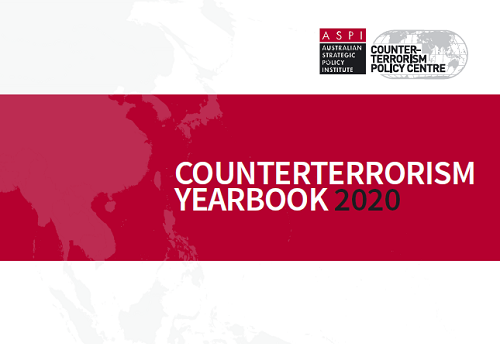REPORTS
Counter Terrorism Yearbook 2020
The 2020 edition of ASPI’s Counterterrorism yearbook continues to provide assessments of how countries and regions are adjusting to terrorist threats. This year’s edition also includes thematic chapters on mental health, strategic policing, the media, the terror–crime nexus and terrorist innovation. These chapters have been included to encourage governments to consider more proactive counterterrorism (CT) agendas that move beyond a focus on disrupting plots and discouraging people from joining and supporting terrorist groups. Such considerations will allow governments to deal with emergent areas of concern, such as game consoles, the role of artificial intelligence and predictive analytics.
The 2020 yearbook was drafted at a time of tremendous upheaval in the global system. We recognise that inter-state tensions are on the rise, and the global system is going through a drastic change as we enter a new decade and new forces and ideas emerge, which is one reason why we’ve included a chapter on right-wing extremism, which we haven’t done before. Despite terrorism developments, attacks are in decline, which has led some states to reduce their threat levels (in November 2019, the UK lowered its terror threat from ‘severe’ to ‘substantial’), due in no small part to positive developments in countering violent extremism.
Three themes emerge from the 2020 yearbook.
First, the experts seem clear that Salafi-jihadi terrorist activities have continued to decline—something that was noticeable as far back as 2015. The decline is very much linked to the demise of ISIL and the fact that al-Qaeda has changed its strategy.
As the number of Salafi-jihadi-inspired terrorist attacks has declined, right-wing extremist activity has increased—a point well illustrated by the terrible Christchurch massacre. The former director-general of ASIO, Duncan Lewis, has noted that while a sophisticated weapons attack by members of this disaggregated community was possible, lone-wolf attacks were more likely. Lewis added that far-right extremist networks ‘are better organised and more sophisticated than those of the past’. To address the growing concern over far-right extremism, we’ve included two chapters on that subject: one by Kristy Campion looking at this phenomenon in Australia and one by Elise Thomas focusing on the Christchurch massacre and the role played by such websites as 8chan. We would argue that even though there isn’t clear evidence of an organised Australian right-wing extremist campaign, security services and governments should keep a close eye on this phenomenon and maintain their commitment to promoting social cohesion.
Second, we address the persistent challenge posed by the demise of ISIL, and specifically the issue of returning foreign fighters and those convicted of terrorism offences who are coming close to the end of their prison sentences. Our experts indicate that there’s a drastic need for the international community to adopt a united, cohesive approach to tackle not only foreign fighters but their dependants. The current disaggregated approach has meant that some countries have taken their foreign fighters back, whereas others have adopted such policies as citizenship revocation or simply refused to tackle the problem. Consequently, there’s a strong likelihood that the problem will grow in time, as these individuals remain radicalised and continue to try to radicalise others, as we’ve seen in prisons, which has led to the introduction of risk and needs assessments. Therefore, states must come together and develop an international response, as opposed to taking an ad hoc approach to the problem.
Third, we recognise the role of technology (specifically, social media) in the evolution of violent extremism. We note that we’re likely to see more cyberterrorism and that extremist groups are likely to continue to use the internet to promote their intolerant views, placing an enormous strain on states that must balance the right to free speech with security.
We note and recognise that security services and policymakers face many challenges that require courageous decisions. We also recognise that there are no easy or cheap solutions to counter violent extremism. This is a battle that we’ll face for many years to come and that demands tremendous investment.
We asked our experts to offer some recommendations in the hope that the yearbook could serve as a guide to policymakers facing these substantial challenges. None of the experts has claimed to have a panacea for the problem of violent extremism. Places such as Syria, Yemen and Mindanao will continue to attract nefarious actors, and post-conflict reconstruction will be expensive and challenging. Conversely, countries such as Australia will have to deal with new threats, such as right-wing-inspired violence.5
We support efforts to promote and encourage social cohesion policies and we identify the pull and push factors that entice young people to join violent extremist groups, but we also wish to emphasise that to have an effective CT policy demands that we address the toxic nature of political discourse, the willingness to revert to ahistoricism and think that just because we’ve been fortunate not to experience terrorist attacks that the problem has gone away. It hasn’t. It’s simply metastasising.
Many will note that this is the first Counterterrorism yearbook that has not had a chapter on Africa. Groups such as al-Shabaab and Boko Haram continue to terrorise their communities, and African governments haven’t adopted more creative policies to deal with those groups and others. We will return to Africa in the next edition of the Counterterrorism yearbook.
We haven’t included a chapter on China and the plight of the Uyghurs, but refer readers instead to the research of ASPI’s International Cyber Policy Centre. We suspect that next year we’ll have to devote more space to such places as Bangladesh, Central Asia, the Caucasus and North Africa, as Salafi-jihadi groups are making inroads in those regions.
We conclude by thanking the contributors, who put enormous effort into their chapters as they sought to provide assessments of terrorist groups but, more importantly, of what CT measures have worked and what needs to be done to ensure that terrorism doesn’t continue to flourish.
SHARE:






